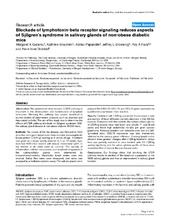| dc.contributor.author | Gatumu, Margaret Karimi | en_US |
| dc.contributor.author | Skarstein, Kathrine | en_US |
| dc.contributor.author | Papandile, Adrian | en_US |
| dc.contributor.author | Browning, Jeffrey L. | en_US |
| dc.contributor.author | Fava, Roy A. | en_US |
| dc.contributor.author | Bolstad, Anne Isine | en_US |
| dc.date.accessioned | 2015-01-20T10:21:45Z | |
| dc.date.available | 2015-01-20T10:21:45Z | |
| dc.date.issued | 2009-02-18 | eng |
| dc.identifier.issn | 1478-6354 | |
| dc.identifier.uri | https://hdl.handle.net/1956/9218 | |
| dc.description.abstract | Introduction The lymphotoxin-beta receptor (LTβR) pathway is important in the development and maintenance of lymphoid structures. Blocking this pathway has proven beneficial in murine models of autoimmune diseases such as diabetes and rheumatoid arthritis. The aim of this study was to determine the effects of LTβR pathway blockade on Sjögren syndrome (SS)-like salivary gland disease in non-obese diabetic (NOD) mice. Methods The course of SS-like disease was followed in NOD mice that were given lymphotoxin-beta receptor-immunoglobulin fusion protein (LTβR-Ig) starting at 9 weeks of age. Treatment was given as a single weekly dose for 3, 7, or 10 weeks. Age-matched NOD mice treated with mouse monoclonal IgG1, or not treated at all, were used as controls. The severity of inflammation, cellular composition, and lymphoid neogenesis in the submandibular glands were determined by immunohistochemistry. Mandibular lymph nodes were also studied. Saliva flow rates were measured, and saliva was analyzed by a multiplex cytokine assay. The salivary glands were analyzed for CXCL13, CCL19, and CCL21 gene expression by quantitative polymerase chain reaction. Results Treatment with LTβR-Ig prevented the increase in size and number of focal infiltrates normally observed in this SS-like disease. Compared with the controls, the submandibular glands of LTβR-Ig-treated mice had fewer and smaller T- and B-cell zones and fewer high endothelial venules per given salivary gland area. Follicular dendritic cell networks were lost in LTβR-Ig-treated mice. CCL19 expression was also dramatically inhibited in the salivary gland infiltrates. Draining lymph nodes showed more gradual changes after LTβR-Ig treatment. Saliva flow was partially restored in mice treated with 10 LTβR-Ig weekly injections, and the saliva cytokine profile of these mice resembled that of mice in the pre-disease state. Conclusions Our findings show that blocking the LTβR pathway results in ablation of the lymphoid organization in the NOD salivary glands and thus an improvement in salivary gland function. | en_US |
| dc.language.iso | eng | eng |
| dc.publisher | BioMed Central | eng |
| dc.rights | Attribution CC BY | eng |
| dc.rights.uri | http://creativecommons.org/licenses/by/2.0 | eng |
| dc.title | Blockade of lymphotoxin-beta receptor signaling reduces aspects of Sjogren's syndrome in salivary glands of non-obese diabetic mice | en_US |
| dc.type | Peer reviewed | |
| dc.type | Journal article | |
| dc.date.updated | 2013-08-28T16:58:26Z | |
| dc.description.version | publishedVersion | en_US |
| dc.rights.holder | Margaret K Gatumu et al.; licensee BioMed Central Ltd. | |
| dc.rights.holder | Copyright 2009 Gatumu et al.; licensee BioMed Central Ltd | |
| dc.source.articlenumber | R24 | |
| dc.identifier.doi | https://doi.org/10.1186/ar2617 | |
| dc.identifier.cristin | 505210 | |
| dc.source.journal | Arthritis Research & Therapy | |
| dc.source.40 | 11 | |

